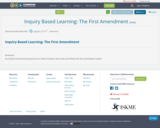
An inquiry based learning projects in which students will study and debate the first amendment rights
- Subject:
- History
- Material Type:
- Lesson Plan
- Date Added:
- 03/15/2017

An inquiry based learning projects in which students will study and debate the first amendment rights
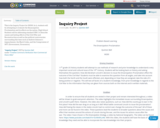
This is the Inquiry Project for W200. In it, students will be attempting to evaluate the Emancipation Proclamation and its effects on the nation. High School Students will be addressing standard USH. 1.4 Describe causes and lasting effects of the Civil War and Reconstruction as well as the political controversies
surrounding this time such as Andrew Johnson’s impeachment, the Black Codes, and the Compromise of
1877. (Government, Economics).
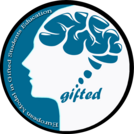
This open resource is designed as an example of interdisciplinary activities on History, Geography and Arts to be used in ELT classes .

The aim of this course is to introduce and analyze the international relations of East Asia. With four great powers, three nuclear weapons states, and two of the world's largest economies, East Asia is one of the most dynamic and consequential regions in world politics. This course will examine the sources of conflict and cooperation in both periods, assessing competing explanations for key events in East Asia's international relations. Readings will be drawn from international relations theory, political science and history.

International Women’s Voices has several objectives. It introduces students to a variety of works by contemporary women writers from Asia, Africa, the Middle East, Latin America and North America. The emphasis is on non-western writers. The readings are chosen to encourage students to think about how each author’s work reflects a distinct cultural heritage and to what extent, if any, we can identify a female voice that transcends national cultures. In lectures and readings distributed in class, students learn about the history and culture of each of the countries these authors represent. The way in which colonialism, religion, nation formation and language influence each writer is a major concern of this course. In addition, students examine the patterns of socialization of women in patriarchal cultures, and how, in the imaginary world, authors resolve or understand the relationship of the characters to love, work, identity, sex roles, marriage, and politics.
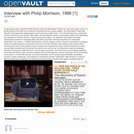
At age twenty-seven, physicist Philip Morrison joined the Manhattan Project, the code name given to the U.S. government's covert effort at Los Alamos to develop the first nuclear weapon. The Manhattan Project was also the most expensive single program ever financed by public funds. In this video segment, Morrison describes the charismatic leadership of his mentor, J. Robert Oppenheimer, and the urgency of their mission to manufacture a weapon 'which if we didn't make first would lead to the loss of the war." In the interview Morrison conducted for War and Peace in the Nuclear Age: 'Dawn,' he describes the remote, inaccessible setting of the laboratory that operated in extreme secrecy. It was this physical isolation, he maintains, that allowed scientists extraordinary freedom to exchange ideas with fellow physicists. Morrison also reflects on his wartime fears. Germany had many of the greatest minds in physics and engineering, which created tremendous anxiety among Allied scientists that it would win the atomic race and the war, and Morrison recalls the elaborate schemes he devised to determine that country's atomic progress. At the time that he was helping assemble the world's first atomic bomb, Morrison believed that nuclear weapons 'could be made part of the construction of the peace.' A month after the war, he toured Hiroshima, and for several years thereafter he testified, became a public spokesman, and lobbied for international nuclear cooperation. After leaving Los Alamos, Morrison returned to academia. For the rest of his life he was a forceful voice against nuclear weapons.
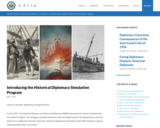
How can we learn diplomacy through history?
In June 2021, the National Museum of American Diplomacy (NMAD) launched the Historical Diplomacy Simulation Program. This program provides educators with the opportunity to bring diplomacy and the work of U.S. diplomats into the classroom. Historical diplomacy simulations also offer teachers a way to internationalize their curriculum.
In most classrooms, discussions about the work of U.S. diplomats and how the U.S. government engages in global issues are absent from the curriculum. To fill this gap, NMAD has developed educational programming to help students better understand diplomacy. These resources show students that many of the opportunities and challenges before the United States are global in source, scope, and solution.
Our signature educational resources are our diplomacy simulations. NMAD’s diplomacy simulations teach students about the work of the U.S. Department of State and the skills and practice of diplomacy as both a concept and a practical set of 21st-century skills. Stepping into the role of diplomats and working in teams, students build rapport with others, present clear arguments, negotiate, find common ground, and compromise to find a potential solution to a real-life historical crisis.
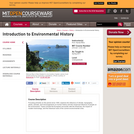
Focusing primarily on the period since 1500, explores the influence of climate, topography, plants, animals, and microorganisms on human history and the reciprocal influence of people on the environment. Topics include the European encounter with the Americas, the impact of modern technology, and the historical roots of the current environmental crisis.

This subject serves as a broad introduction to the field of European and Latin American fiction. It is designed to help students acquire a general understanding of major fictional modes. We will pay attention not only to the literary movements these works represent, but also to the subtle interplay of history, geography, language and cultural norms that gave rise to specific literary forms. The books we read in this course are compelling, and film versions of five of the works we read give variety to the course and time to think about the interplay of film and print.
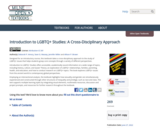
Designed for an introductory course, this textbook takes a cross-disciplinary approach to the study of LGBTQ+ issues that helps students grasp core concepts through a variety of different perspectives.
Introduction to LGBTQ+ Studies offers accessible, academically sound information on a wide range of topics, including history, culture, and Queer Theory; an exploration of LGBTQ+ relationships, families, parenting, health, and education; and how to conduct research on LGBTQ+ topics. The book explores LGBTQ+ issues from the ancient world to contemporary global perspectives.
Employing an intersectional analysis, the textbook highlights how sexuality and gender are simultaneously experienced and constructed through other structures of inequality and privilege, such as race and class. The text supports multiple learning styles by integrating visual elements, multimedia resources, discussion and project prompts, and resources for further research throughout the textbook.
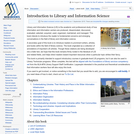
Library and Information Science (LIS) is the academic and professional study of how information and information carriers are produced, disseminated, discovered, evaluated, selected, acquired, used, organized, maintained, and managed. This book intends to introduce the reader to fundamental concerns and emerging conversations in the field of library and information science.
A secondary goal of this book is to introduce readers to prominent writers, articles, and books within the field of library science. The book originated as a collection of annotations of important LIS articles. Though these citations are being developed into a fuller text, we hope that this book remains firmly rooted in the literature of LIS and related fields, and helps direct readers toward important resources when a particular topic strikes their fancy.

Introduction to Media Studies is designed for students who have grown up in a rapidly changing global multimedia environment and want to become more literate and critical consumers and producers of culture. Through an interdisciplinary comparative and historical lens, the course defines "media" broadly as including oral, print, theatrical, photographic, broadcast, cinematic, and digital cultural forms and practices. The course looks at the nature of mediated communication, the functions of media, the history of transformations in media and the institutions that help define media's place in society.
Over the course of the semester we explore different theoretical perspectives on the role and power of media in society in influencing our social values, political beliefs, identities and behaviors. Students also have the opportunity to analyze specific media texts (such as films and television shows) and explore the meaning of the changes that occur when a particular narrative is adapted into different media forms. We look at the ways in which the politics of class, gender and race influence both the production and reception of media. To represent different perspectives on media, several guest speakers also present lectures. Through the readings, lectures, and discussions as well as their own writing and oral presentations, students have multiple opportunities to engage with critical debates in the field as well as explore the role of media in their own lives.
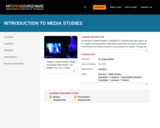
Offers an overview of the social, cultural, political, and economic impact of mediated communication on modern culture. Combines critical discussions with hands-on "experiments" working with different media. Media covered include radio, television, film, the printed word, and digital technologies. Topics include the nature and function of media, core media institutions, and media in transition.
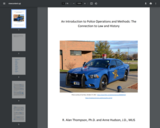
An Introductory text about police operations and methods.

This course has several purposes. The major concern will be the examination of Spanish culture including Spain's history, architecture, art, literature and film, to determine if there is a uniquely Spanish manner of seeing and understanding the world - one which emerges as clearly distinct from our own and that of other Western European nations.
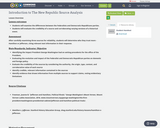
Lesson outcomesStudents will examine the differences between the Federalists and Democratic-Republicans parties.Students will evaluate the credibility of a source and corroborating varying versions of a historical event.AssessmentAfter carefully examining three sources for reliability, students will determine who they trust more - Hamilton or Jefferson, citing relevant text information in their response.State Standards, Indicator, ObjectiveIdentifying the impact President George Washington had on setting precedents for the office of the President.Evaluating the evolution and impact of the Federalist and Democratic-Republican parties on domestic and foreign policy.Evaluate the credibility of the sources by considering the authority, the origin, type, context, and corroborative value of each sourceIdentify credible, relevant information contained in the sourcesIdentify evidence that draws information from multiple sources to support claims, noting evidentiary limitations

This is a module framework. It can be viewed online or downloaded as a zip file.
As taught Autumn Semester 2010
Most history students, when applying to university, say they want to widen their knowledge of the past. As a School we take you at your word, teaching history from AD 500 onwards. This module introduces you to Europe in the Middle Ages (500-1500), a period in which Nottingham University has a distinguished tradition, built up by Jim Holt, Donald Bullough, Robert Markus, Bernard Hamilton and Michael Jones, and continued, we hope, by ourselves. The period covered by the module runs from the end of the Roman Empire in the west to the Renaissance. The legacy of this period is still with us: disputed notions of what constitutes European ‘unity’; profound divisions between West and East (and North and South); clashes between Christian and non-Christian cultures, especially Judaism and Islam. The module will introduce you to current historical debates and to a range of primary sources, in English translation, which will allow you to test your existing critical skills on unfamiliar and challenging material; in this respect it links effectively with the Learning History module. We hope that you will enjoy learning about this distant but formative period of European history, highly relevant to many of the dramatic changes taking place in Europe and the wider world today. If you do, remember that you can continue to study it throughout your time here.
Module Code: V11219
Suitable for study at: Undergraduate level 1
Credits:20
School of History:
Our teaching and learning methods, at both undergraduate and postgraduate levels, are strongly focused on 'active learning'. We emphasise that effective learning in History comes especially from one's own enquiries, critical thinking, and reflection.
You will therefore be encouraged to become independent learners and thinkers, whilst being guided by expert tutors. Active participation and involvement in class discussion and group activities are therefore given priority as a means of developing skills required for learning, researching and employment.
Our academic staff are central to our success and create our lively and inclusive research culture. All of them are nationally or internationally recognized scholars in their fields.

The purpose of this course is to explore the foundations of the Humanities and to increase our understanding of the relationship between history and philosophy and how these relate to the issues concerning the human condition. During this course we will learn about some of the many traditions in the humanities, including the foundations of artistic expression. One of my main goals for this course is to demonstrate that every aspect of the humanities (art, history, philosophy, science, etc.) are all inherently related, and that we cannot accurately study one component of society or humanity without having a working understanding of the related components.
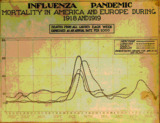
This resource uses Gholdy Muhammad's Layered Text strategy to pull students into a multimodal lesson providing context for the 1918 Pandemic.

This course explores the historical origins of the Japanese warrior class as well as its reinvention throughout the archipelago's history, with a special focus on the pre-modern era (200–1600 CE). It highlights key historical contexts including the rise of the imperial court, interactions with the broader world, and the establishment of a warrior-dominated state. It also considers the modern imaginations and uses of the warrior figure.
Note: This course is taught in English with a project that requires research in Japanese.